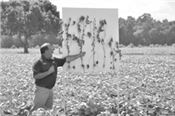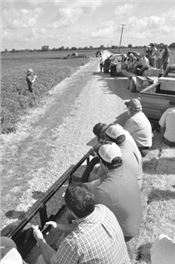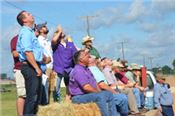|
La. Farmers Seeing Few Problems In Fields This Year
ALEXANDRIA, LA.
Row crop farmers and consultants attending the LSU AgCenter Dean Lee Research Station field day on July 14 heard about research to help them improve their operations and increase profits.
AgCenter entomologist Julien Beuzelin said sugarcane aphids have been less of a problem this year in grain sorghum, although late-season infestations could still cause trouble during harvest. The aphids leave behind a sticky honeydew that clogs harvesters.
It’s important to avoid planting sorghum hybrids that are susceptible to the aphids, Beuzelin said. Planting early in April and using neonicotinoid seed treatments also reduce the need for insecticide treatment.
Farmers should not spray unless they see at least 50 aphids on 20 percent of sorghum leaves, Beuzelin said. The insecticides Transform and Sivanto offer good aphid control.
Redbanded stinkbugs and soybean loopers continue to be a concern for soybean farmers, but pressure from those insects has been light so far, despite a warm winter, said AgCenter entomologist Jeff Davis.
Redbanded stinkbugs reproduce quickly and are difficult to control, but they can be controlled fairly well with pyrethroid insecticides or pre-mixes of pyrethroids and neonicotinoids, Davis said. Spraying for the stinkbugs, however, tends to cause soybean looper populations to flare up.
Davis said he’s also seen some infestations of potato leafhoppers, whose saliva burns plants and causes leaves to cup and curl. The leafhoppers can be controlled with pyrethroids.
It’s been a relatively quiet year as far as diseases are concerned, said AgCenter plant pathologist Trey Price.
The corn crop in central Louisiana looks very good, with only a few reports of downy mildew, Northern corn leaf blight and Southern rust in the area. Those diseases should not cause significant problems and do not warrant spraying.
Frogeye leaf spot, a major concern in soybeans in recent years, has yet to show up in central Louisiana this year, Price said. Soybean rust was found a few weeks ago in Iberville Parish and may surface elsewhere in the state in later-planted soybeans, but it should not pose any serious problems.
Taproot decline, a disease that tends to show up in no-till or minimally tilled soybean fields, continues to be a concern, Price said. Tillage and crop rotation should help manage the disease, which harms plant roots and causes leaves to yellow at the pod-filling growth stage.
Price said he’s seen few problems in grain sorghum and cotton this year and urged farmers to spray fungicides only when diseases are present and treatment is necessary.
AgCenter engineer Randy Price and extension agent Jimmy Flanagan talked about using unmanned aerial vehicles, or drones, to monitor fields. Price said drone technology has been improving quickly, with some drones now able to fly over 100- to 200-acre fields on a single battery charge. Some models also have a Wi-Fi link that makes it easier for the pilot to keep track of the drone.
The Federal Aviation Administration is expected to set rules on the use of drones soon, Price said. Pilots won’t be able to fly drones higher than 400 feet and must keep them within eyesight. They will also have to take a ground school exam at their local airport.
Flanagan said drones have many potential uses in the agriculture industry, especially for consultants. “This will be another tool in your arsenal to manage your crops,” he said.
AgCenter economist Naveen Adusumilli said regulations for the U.S. Environmental Protection Agency’s Clean Water Rule still are not finalized; however, a recent ruling in a California lawsuit has created confusion on what is exempted from regulation and how the regulations will be enforced.
Adusumilli also talked about changes to the Natural Resources Conservation Service Environmental Quality Incentives Program (EQIP) being made at the national level. Unlike in some states, Louisiana still requires certain conditions to be met before a producer can irrigate for the first time, he said.
AgCenter weed scientist Daniel Stephenson said excessive heat can interfere with a herbicide’s effectiveness. “If the plant is not actively growing, the plant will not translocate the herbicide,” he said.
Some farmers are reluctant to use a pre-emerge herbicide because they are concerned they will damage a soybean crop, but tests have not shown any long-term effects. “I have yet to ever see a yield reduction from a pre-emerge herbicide in my research,” Stephenson said.
A pre-emerge herbicide will provide three to four weeks of control if activated by rain or overhead irrigation, he said.
Herbicide-resistant weeds in Arkansas can no longer be controlled by anything other than Liberty herbicide, he said.
Some farmers growing Xtend soybeans are illegally applying dicamba, even though the U.S. Environmental Protection Agency has yet to approve the herbicide on soybeans. Stephenson warned that illegal applications of dicamba or any other herbicide could lead to criminal prosecution and additional governmental scrutiny for agriculture.
AgCenter cotton, corn and grain sorghum specialist Dan Fromme gave an overview of his research projects for the three commodities that include variety trials and seeding rate studies. He also is conducting a cover crop study on a commercial farm.
Fromme said his work has been made possible from Cotton Inc. and the Louisiana Soybean and Feed Grain Board.
Fromme expects a good corn yield in central and southern Louisiana. “Yields here probably will be the best we’ve had – as good as or better than 2014 or 2015,” he said. The milo crop looks good, and this year’s sugarcane aphid problem has not been as bad so far. The cotton crop varies throughout the state.
AgCenter entomologist David Kerns said variety resistance is being studied as a control measure against sugarcane aphids in milo.
A study is underway with cotton to determine the yield effects of losing squares. Work so far has shown that cotton plants can compensate for losing all squares early in the growing season, although fiber quality could be affected, Kerns said.
Some farmers are switching back to non-Bt cotton because insects are becoming resistant to the transgenic varieties with the Bt trait, he said.
AgCenter soybean specialist Ron Levy said the optimum planting time for soybeans is mid-April. Wet, cool soil conditions are not good for early planting. Excessively high nighttime temperatures will affect yield, he said, because the plant uses its energy to stay cool.
Fields with bad nematode pressure should be planted with milo as a rotation crop to control the pest, Levy said.
Levy is studying the addition of potassium and phosphorous to the soil in a soybean crop. Adding nitrogen for soybeans is not recommended because the plant fixes nitrogen in its root system.
Rogers Leonard, LSU AgCenter associate vice president, said the quality of work being done at Dean Lee and other facilities around the state remains excellent despite reductions in research and extension personnel.
“We now have a strong integration of efforts,” Leonard said, noting that the AgCenter has become more efficient amid recent budget cuts.
It’s possible that some of the 17 AgCenter research stations will be refocused to have more specialized missions with fewer staff members. Though the state Legislature did not cut the AgCenter budget this year, the state budget could still face a shortfall that could require cutting the budget up to 5 percent, he said.
Kadan Guillory, an Allen Parish 4-H’er who served as state president during the past school year, told attendees about the value of AgCenter 4-H youth development programs, such as service projects and camps.
“4-H has changed my life in so many ways I never thought possible,” said Guillory, who plans to attend LSU in the fall. ∆

LSU AgCenter soybean specialist Ron Levy talks about the benefits of planting soybeans
early during the LSU AgCenter Dean Lee Research Station field day.

LSU AgCenter plant pathologist Trey Price describes some of the disease problems that
soybean farmers are having this year during the LSU AgCenter Dean Lee Research Station field day.

Attendees of the LSU AgCenter Dean Lee
Research Station field day on July 14 watch a drone hover over a soybean field.
|
|